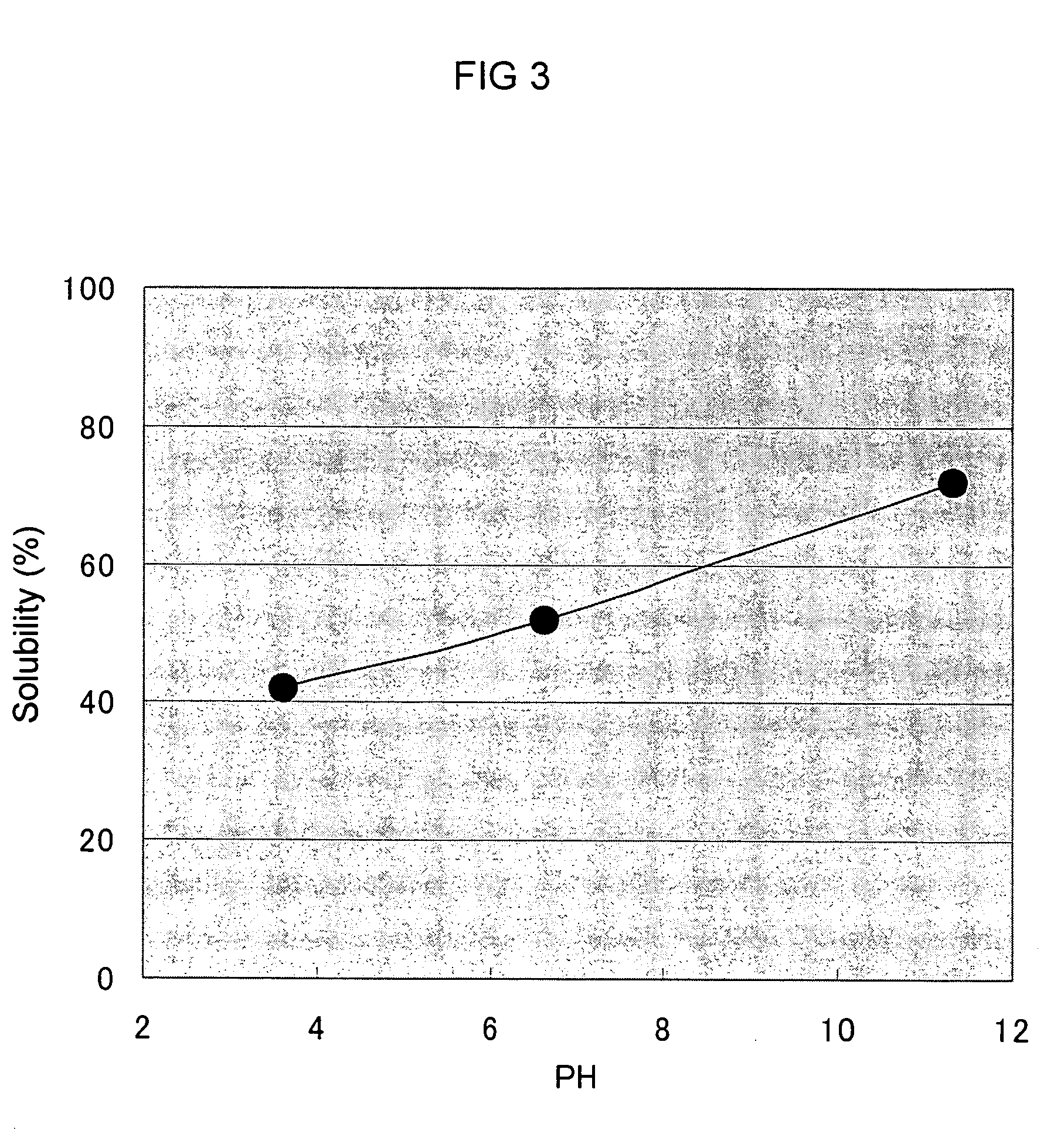Beta-1, 3-1, 6-D-glucan and its use
a technology of glucan and beta-1, 3-1, can solve the problems of difficult separation of insoluble materials such as cells from culture medium by filtration or centrifugation in the industrial scale, and difficulty in purifying from medium,
- Summary
- Abstract
- Description
- Claims
- Application Information
AI Technical Summary
Problems solved by technology
Method used
Image
Examples
example 2
Use of Aureobasidium sp. K-1
1) Production of β-glucan by Cultivation 2
[0106] The aqueous culture medium (60 ml) consisting of the ingredients shown in Table 4 was added into a 300 ml-Erlenmeyer flask, and after the medium was autoclaved and sterilized at 121° C. for 15 minutes, a loopful of Aureobasidium sp. K-1 in the slant medium was aseptically inoculated and aerobically cultured for 96 hours at 30° C. at 130 rpm to prepare a seed culture medium. After 96 hours the turbidity of cells was 35 OD at OD 660 nm, and the content of polysaccharide was 0.5% (w / v). To the cell-removed supernatant was added ethanol so that the final concentration became 66%, and β-glucan was recovered. Then, the glucan was again dissolved in ion-exchange water and centrifuged and then, to the supernatant was added brine so that the final concentration became 0.9%, and then, β-glucan was recovered with 66% ethanol. This β-glucan recovery procedures were repeated twice, thus obtained aqueous β-glucan sol...
example 3
Use of Aureobasidium pullulans GM-NH-1A2
[0110] By using Aureobasidium pullulans GM-NH-1A2 in stead of Aureobasidium pullulans GM-NH-1A1, the procedure was conducted in the same manner as in Example 1. As a result, the concentration of polysaccharide produced was 0.5% (w / v), and its viscosity was 1300 cP ([mPa.s]). In the same way as Example 2, to the medium prepared was added sodium hydroxide so that the final concentration became 2.4% (w / v) and the mixture was stirred (pH13.6). Then, the solution was neutralized with 50% (w / v) citric acid to pH5.0. By measuring the viscosity in the same way as in Example 1, it was 7 cP ([mPa.s]). The concentration of the polysaccharide was 0.5 (w / v) at that time.
[0111] The property on the polysaccharide was tested in the same manner as in Example 1.
[0112] As a result of the investigation on the sift effect by congo red, the sifted from maximum absorption, 480 nm to around 525 nm was observed. The sift differences to maximum was Δ0.45 / 500 μg pol...
example 4
Change of Ingredients in Medium
[0114] Except changing the strain into Aureobasidium pullulans GM-NH-1A2 and without using ascorbic acid in Table 4, the procedure was carried out in the same manner as in Example 1. As a result, the concentration of the polysaccharide produced was 0.6%, and its viscosity was 1500 cP ([mPa.s]) at that time. In the same way as Example 2, to this medium obtained was added 25% (w / w) sodium hydroxide so that the final concentration became 2.4% (w / v) and the mixture was stirred (pH13.6). Then, the solution was neutralized with 50% (w / v) citric acid to pH 5.0 and the viscosity was measured in the same manner as in Example 1. The viscosity decreased to 7 cP ([mPa.s]).
[0115] From the result of the investigation on the sifting effect by Congo red, the sifted from maximum absorption, 480 nm to around 525 nm was observed. The sifting differences to maximum were Δ0.45 / 500 μg polysaccharide.
[0116] Furthermore, two dimensional NMR (13C—1H COSY NMR) analysis was ...
PUM
| Property | Measurement | Unit |
|---|---|---|
| viscosity | aaaaa | aaaaa |
| concentration | aaaaa | aaaaa |
| pressure | aaaaa | aaaaa |
Abstract
Description
Claims
Application Information
 Login to View More
Login to View More - R&D
- Intellectual Property
- Life Sciences
- Materials
- Tech Scout
- Unparalleled Data Quality
- Higher Quality Content
- 60% Fewer Hallucinations
Browse by: Latest US Patents, China's latest patents, Technical Efficacy Thesaurus, Application Domain, Technology Topic, Popular Technical Reports.
© 2025 PatSnap. All rights reserved.Legal|Privacy policy|Modern Slavery Act Transparency Statement|Sitemap|About US| Contact US: help@patsnap.com



